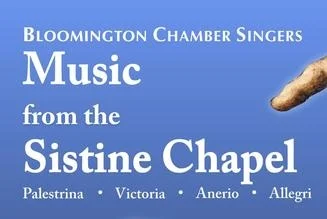We opened our 49th season Saturday evening, November 10th, 2018, 7:30pm in the resonant sanctuary at St. Mark's United Methodist Church, with an evening of a cappella music in the pure, ethereal style of the High Renaissance.
Music from the Sistine Chapel presented works composed for the late sixteenth century Papal Court. Featured was Palestrina's Missa Papae Marcelli, a work that enjoys an almost mythical reputation for having "saved" polyphony by ensuring the intelligibility of the text. Also on the concert were large-scale motets, including Allegri's famed Miserere and Lotti's Crucifixus.
The profound intellectual, artistic, and cultural developments that transformed European thinking from the late Medieval period through the sixteenth century permeated music. Music evolved into multiple voices intertwining complex and rich vocal polyphony, all the while exploring the gradual shift from modality to tonality. These remarkable new innovations overlaid with texts deeply rooted in sacred liturgy move listeners of all backgrounds. The Chamber Singers’ focus on authentic performance practice and passionate connections with the music shine through every performance. As an auditioned group of about 40 singers, the choir demonstrates a commitment to attaining the highest standards of choral music.
Here is the program booklet for our concert: Sistine Chapel Program.
You can find a short clip of our concert here.
Here is a review of our concert in the Bloomington Herald-Times:
Piece from the 1550s retains beauty, clarity in singers' performance
By Peter Jacobi H-T Reviewer Nov 12, 2018
The centerpiece of the Bloomington Chamber Singers’ remarkable concert Saturday evening was Giovanni Pierluigi da Palestrina’s “Missa Papae Marcelli,” written in the 1550s for the election of Pope Marcellus II. It is a work of distinctive beauty and clarity and, fortunately, was sung that way.The composition was Palestrina’s immediate response to an edict from the Council of Trent, an ecumenical gathering prompted by the Protestant Reformation that called on composers to set the Mass to music designed to keep the words clear, unencumbered by excessive counterpoint.
Palestrina’s continuing fame rests very much on the “Missa Papae Marcelli,” not so much by now because of its loyalty to a 16th century council order but because it is an absolutely radiant piece of music that reveals the stunning genius of its inspired creator. Saturday’s reading of the piece indicated that the Bloomington Chamber Singers (BCS), a community choir, had been inspired by long-time music director and conductor Gerald Sousa to master and occupy music of great complexity, enriched by polyphony and an ethereal sound not easily grasped by singers attempting to re-create its substance and spirit close to five centuries after written.
And to do so for an audience equally distant, gathered not in a Catholic church for prayer but for artistic sustenance and, perhaps, psychological calm in the sanctuary of a Protestant denomination, St. Mark’s United Methodist Church.
A centerpiece, as the Mass was described above, has to have an environment. And it did. Maestro Sousa placed it within a program titled “Music of the Sistine Chapel,” and that meant companion works, liturgical pieces for the voice written during the Renaissance, masses and motets, by Antoine Brumel, Josquin Desprez, Tomas Luis de Victoria, Felice Anerio, Antonio Lotti, and Orlando de Lassus. Each offered its challenges, and for Sousa’s forces to have captured the lot was an amazing feat.
One heard music of sorrow, of search for enhanced faith, for spiritual peace, for emotional calm, for reduction of fear. The mood throughout engendered quiet, even when blended with intensity.
Toward the end of the hour-long program, Sousa placed the still well-known and much admired “Miserere” of Gregorio Allegri, a series of responses for full choir, small choir, and solos, with words spoken and words delivered by sopranos heaven-high, with shifting rhythms and altering tonal weights, with texts expressing hope for God’s mercy against human transgressions. In effects, the Allegri departed from the rest of this Sistine musical journey but remained a historical and spiritual fit. Sousa and company delivered the “Miserere” with confidence and persuasiveness.
The program in entirety was one the performers could be proud of.
(link)



